
Fresh DIY Garden Bed Ideas to Elevate Your Backyard

A garden bed sets the tone for any outdoor space, offering structure, personality, and a burst of life. Building your own garden beds opens endless possibilities, from rustic wooden frames to upcycled containers full of charm. With the right approach, even a small backyard can feel like a lush retreat filled with color and texture.
Raised beds give plants better soil drainage, while tiered designs bring depth and visual interest. Old pallets, stone borders, or even repurposed barrels can become striking foundations for flowers, herbs, or vegetables.
Every design choice reflects personal taste and sparks creativity, turning a simple patch of soil into a vibrant focal point. Stylish garden beds don’t just showcase plants; they also enhance relaxation, making outdoor time more rewarding. Dive into fresh DIY ideas and see how small changes can spark big inspiration for your green haven.
10DIY Garden Bed Ideas
Gardening gives peace, joy, and fresh produce. A garden bed makes it easier to grow flowers, herbs, and vegetables. Building your own bed saves money and lets you design it the way you like. With the right materials, you can set up a bed that looks good and lasts long. Here are ten DIY garden bed ideas you can try at home.
1. Wooden Raised Garden Bed
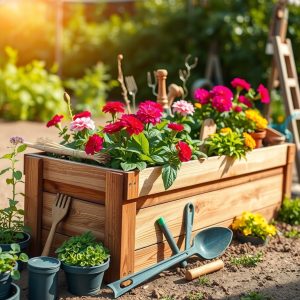
Wood is the most popular material for garden beds. It is easy to find and simple to cut. Pine, cedar, or redwood work well. Cedar lasts longer because it resists rot.
To build, measure the size of your bed. A common size is 4 feet by 8 feet. Cut the wood to size and screw the boards together. Place the frame in a sunny spot. Fill with soil and compost. This style makes planting and weeding much easier.
Tip: Line the bottom with cardboard before adding soil. It blocks weeds from growing.
2. Cinder Block Garden Bed
Cinder blocks are cheap and sturdy. They last many years and do not rot. Arrange them in a rectangle or square. Each block has holes where you can also grow herbs or flowers.
This design needs no nails or screws. Just stack the blocks where you want the bed. Fill the middle with soil and plant your crops. The small pockets on the blocks are perfect for growing strawberries, basil, or marigolds.
Tip: Paint the outside of the blocks to make the bed look brighter.
3. Metal Garden Bed
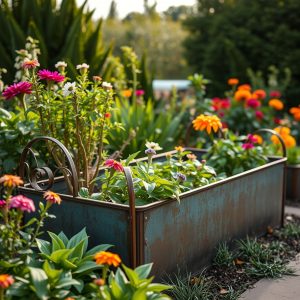
Corrugated metal panels create a modern look. These panels are strong and resist weather damage. You can attach them with wooden posts at each corner for stability.
Cut the panels to the height you want. Many gardeners choose 2 feet tall beds. This keeps rabbits and pets away from the plants. Metal beds warm up faster in spring, which helps seeds grow early.
Tip: Add a wooden trim at the top edge. It makes the bed safer and more comfortable to lean on.
4. Pallet Garden Bed
Old wooden pallets are easy to find. They make a free or low-cost garden bed. Take apart the pallet and use the planks to build a square or rectangle frame.
You can also use the pallet as a vertical bed by standing it upright. Just add landscape fabric at the back and bottom to hold soil in place. Then plant herbs, lettuce, or flowers inside the open slats.
Tip: Sand the wood before using it. This prevents splinters and gives the bed a smooth finish.
5. Stone Garden Bed
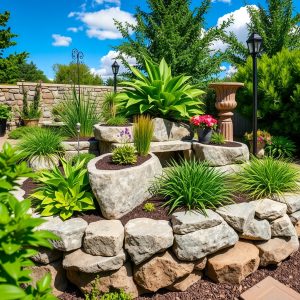
Natural stone gives a rustic and solid look. Collect stones from your yard or buy them from a garden center. Stack them to form a wall around the garden area.
Make sure the stones are stable so they do not fall. Place the largest stones at the bottom and smaller ones on top. This type of bed blends well with nature and lasts for years without repair.
Tip: Add gravel at the bottom before the soil. It improves drainage for plants.
6. Woven Branch Garden Bed
Branches and sticks can be turned into a beautiful woven garden bed. This style is also called a wattle fence. Collect long, flexible branches such as willow or hazel.
Push sturdy sticks into the ground as posts. Then weave thinner branches in and out to make walls. The woven design holds soil while giving a natural look. It works well in a cottage garden style.
Tip: Use fresh green branches. They bend easily without breaking.
7. Tire Garden Bed
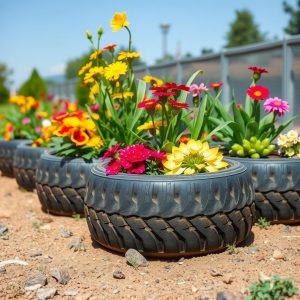
Old tires can be recycled into garden beds. They are strong and easy to move. Place a tire on the ground, fill it with soil, and plant inside.
For taller beds, stack two or three tires. Paint them with bright colors to make the space more cheerful. Tire beds work well for flowers, herbs, and even small vegetables.
Tip: Drill small holes at the bottom for drainage before adding soil.
8. Hugelkultur Garden Bed
This is a type of raised bed built with logs, branches, and organic waste. Start by digging a shallow trench. Place logs and large branches at the bottom. Add leaves, grass clippings, and compost on top. Finally, cover with soil.
The wood breaks down slowly and creates rich soil over time. This bed also holds water better, so you water less. It works well for big gardens where space allows a mound-shaped bed.
Tip: Avoid using black walnut or cedar wood, as they may harm plants.
9. Recycled Container Garden Bed
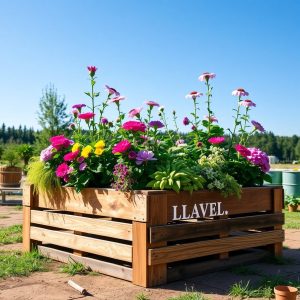
Old bathtubs, troughs, barrels, and even crates can become garden beds. This is a great way to recycle while adding character to the garden.
Drill drainage holes at the bottom. Place the container where you want it and fill with soil. These beds are movable and good for renters who may change homes.
Tip: Use lightweight containers if you plan to move them often.
10. Keyhole Garden Bed
A keyhole garden is round with a path that leads to the center, making it look like a keyhole from above. The center has a compost basket made from sticks or wire mesh. Kitchen scraps go into the basket, feeding the plants with nutrients.
This type of bed works well in dry areas because it holds moisture. You can plant vegetables all around the circle and reach them easily from the path.
Tip: Build the walls with stone, brick, or wood. Make it about 3 feet tall for comfort.
FAQs
How deep should a garden bed be?
A garden bed should be at least 12 inches deep. For root vegetables like carrots, 18 inches is better.
What is the best soil mix for garden beds?
A mix of one-third topsoil, one-third compost, and one-third coarse sand or perlite works well.
Do raised beds need drainage holes?
Yes, good drainage prevents root rot. If your bed sits on the ground, loosen the soil underneath. For containers, drill holes at the bottom.
Which wood is safe for garden beds?
Cedar, pine, and redwood are safe choices. Avoid treated wood with chemicals, as it may harm plants.
How wide should a garden bed be?
Four feet wide is ideal. You can reach the middle from either side without stepping inside.
Conclusion
Building a DIY garden bed is simple and rewarding. Wood, stone, metal, or recycled items all make great options. Each style has its own look and benefits. Start small and choose a design that fits your space. With the right bed, plants grow healthier and the garden becomes easier to manage.
